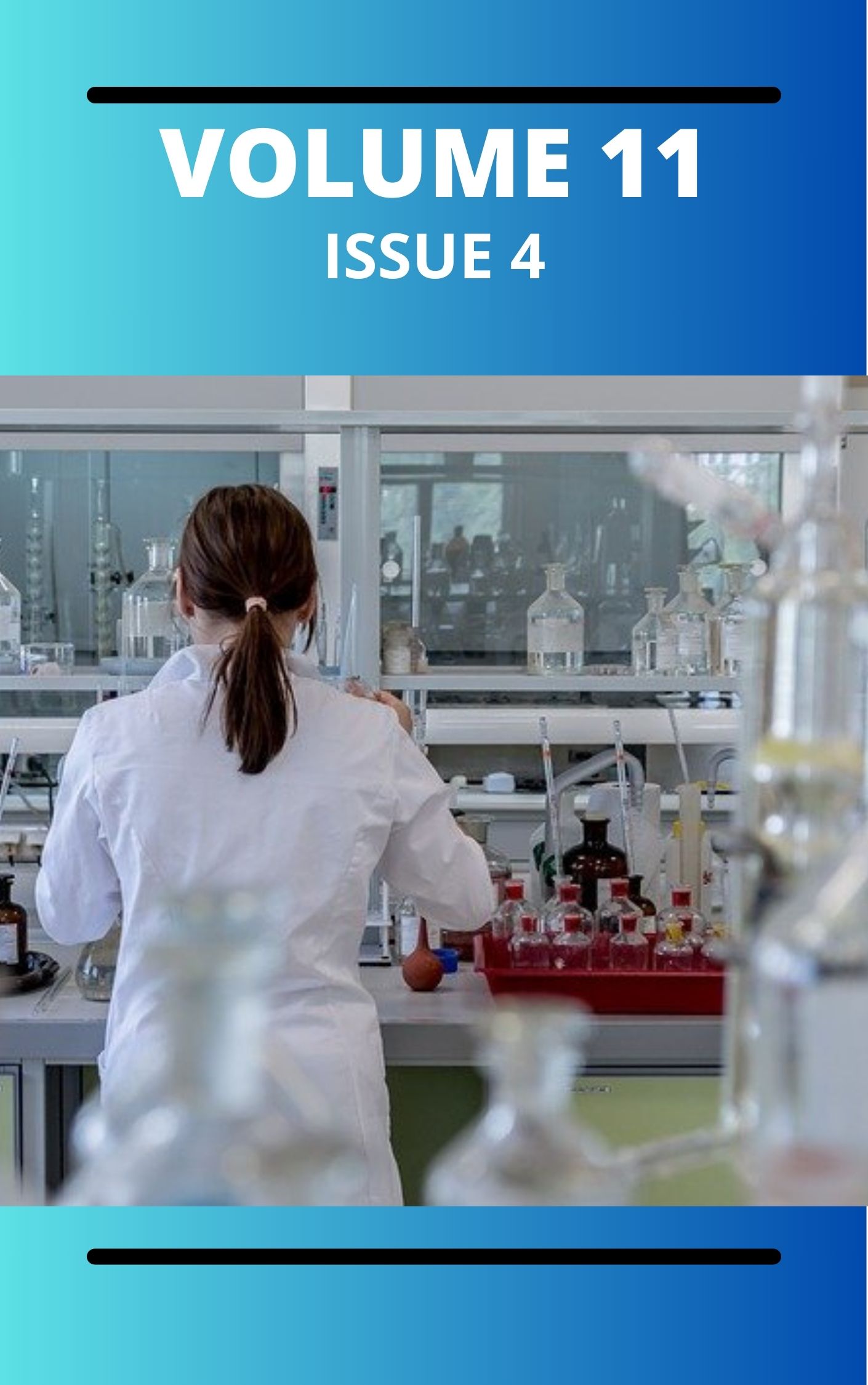Crystal Structure, in Silico Studies and Anti-diabetic Potentials of 3-e-(1,5-dimethyl-3-oxo-2-phenyl-2,3-dihydro-1h-pyrazol-4-yl)hyd -razinylidene]pentane-2,4-dione(hdpp)and its Cu(II) and Ni(II) complexes
DOI:
https://doi.org/10.4314/2cv4bb03Keywords:
Hydrazone, X- ray crystallography, Co(II), Ni(II), Cu(II) and Fe(III) complexes, In silico and antidiabetic studiesAbstract
The hydrazone, 3-E-[2-(1,5-Dimethyl-3-oxo-2-Phenyl-2,3-Dihydro-1h-Pyrazol-4-yl)Hydrazinylidene]Pentane-2,4-dione, HDPP was synthesized by coupling diazotized 4-aminoantipyrine with pentan-2,4-dione at < 5 0C. The Cu(II) and Ni(II) complexes were prepared by refluxing stoichiometric amounts of metal salts and HDPP in ethanol for 6 h at 60 0C. The ligand and complexes were characterized by UV-Vis, IR, NMR, and mass spectroscopies as well as by C, H, N, S elemental analysis, conductivity measurement, quantitative chloride determination and single crystal X-ray diffraction analysis. The compounds were screened in vitro for antibacterial activity against P. aeruginosa, S. aureus, Ecoli(Eco 6), E. coli(13), B. subtilis, S. pneumonia, P. mirabilis, S. intermedius and K. pneumoniae. The compounds were assayed for in silico molecular docking and in vivo anti-diabetic potentials. FTIR data showed shifts in ⱱ(C=O), ⱱ(N=H) and ⱱ(C=N) of the complexes implicating the involvement of these groups in complexation. Proton NMR shifts accounted for the methyl, phenyl and N-H protons of the ligand but indecipherable for the complexes due to paramagnetic effects. Conductivity values of HDPP and complexes showed the ligand and its complexes to be neutral. X-ray crystallographic data of HDPP show the ligand to have orthorhombic crystals with pbca unit cell a = 28.501(4) Å, α = 90°, b = 15.0494(19) Å, β = 90°; and c = 7.3234(9) Å, γ = 90° with Z=8. HDPP and its complexes exist in hydrazo form instead of azo form. It showed no activity against test organisms, but the complexes showed various degrees of sensitivities against the test bacterial strain at 10μg/cm3. Acute toxicity (LD50) tests showed that HDPP and [Cu(HDPP)2Cl2] were non-toxic. In silico studies proved them to be drug candidates for diabetes with good oral bioavailability. In vivo, antidiabetic tests showed HDPP and [Cu(HDPP)2Cl2] to reduce the blood level of diabetic rats to within 61 to 67% better than the control drug glibenclamide within 14 days of treatment.
Downloads
Published
Issue
Section
Most read articles by the same author(s)
- Uchechukwu Susan Oruma, Pius Oziri Ukoha, Collins U. Ibeji, Lawrence Nnamdi Obasi, Obinna C. Okpareke, Ebubechukwu N. Dim, Klaus Jurkschat, Ponnadurai Ramasami, Synthesis, Spectroscopic, Biological and DFT Studies of 2,4,6-Tris(4-Carboxyphenylimino-41-Formylphenoxy)-1,3,5-Triazine and its Trinuclear Dy(III) and Er(III) Salen Capped Complexes , Communication In Physical Sciences: Vol. 7 No. 3 (2021): VOLUME 7 ISSUE 3
- Uchechukwu Susan Oruma, Pius Oziri Ukoha, Lawrence Nnamdi Obasi, Synthesis, Characterization and Biological Studies of Trinuclear Ce(IV) Salen Capped Complex with 5-amino-2,4,6-tris(4-carboxybenzimino)-1,3-pyrimidine , Communication In Physical Sciences: Vol. 5 No. 3 (2020): VOLUME 5 ISSUE 3
Similar Articles
- Esharive Ogaga, Onimisi Martins, Abdulateef Onimisi Jimoh, Akudo Ernest orji, Aigbadon Godwin Okumagbe, Achegbulu Ojonimi Emmanuel, Assessment of Geotechnical Attributes of Laterites as Sub-base and Sub-Grade Materials in Parts of Northern Anambra Basin Nigeria: Implications for Road Pavement Construction , Communication In Physical Sciences: Vol. 11 No. 3 (2024): VOLUME 11 ISSUE 3
- Joseph Amajama, Ahmed Tunde Ibrahim , Julius Ushie Akwagiobe, Influence of Atmospheric Temperature on the Signal Strength of Mobile Phone Communication , Communication In Physical Sciences: Vol. 9 No. 4 (2023): VOLUME 9 ISSUE 4
- Usoro M. Etesin, Hydrochemical study of shallow ground water in Ikot Abasi Coastal Aquifer , Communication In Physical Sciences: Vol. 7 No. 3 (2021): VOLUME 7 ISSUE 3
- Onen Alfred Ikpi , Emmanuel E. Etim, Abah Abraham Victor, Ogofotha Godwin Oghenekeno, Improved Photochemical Performance of Dye-Sensitized Solar Cell using Tectona grandis and Magnifera indica Dye Mix , Communication In Physical Sciences: Vol. 9 No. 2 (2023): VOLUME 9 ISSUE 2
- Michael Oladipo Akinsanya, Oluwafemi Clement Adeusi, Kazeem Bamidele Ajanaku, A Detailed Review of Contemporary Cyber/Network Security Approaches and Emerging Challenges , Communication In Physical Sciences: Vol. 8 No. 4 (2022): VOLUME 8 ISSUE 4
- N. B. Essien, Sorghum Waste as an Efficient Adsorbent for the Removal of Zn2+and Cu2+ from Aqueous Medium , Communication In Physical Sciences: Vol. 5 No. 2 (2020): VOLUME 5 ISSUE 2
- Amaku James Friday, Victor Okezie Ikpeazu, Ifeanyi Otuokere, K. K. Igwe, Bioactive phenolic compounds isolated in morus alba leaves as potential inhibitor of Hepatitis C Virus NS3 Protease: A molecular docking approach , Communication In Physical Sciences: Vol. 5 No. 4 (2020): VOLUME 5 ISSUE 4
- E. D. Paul, Casmir Emmanuel Gimba, ATR-FTIR Quantitation of Isopropyl Alcohol (IPA) and Ethanol in Some Covid-19 Targeted Hand Sanitizers in Nigeria , Communication In Physical Sciences: Vol. 7 No. 1 (2021): VOLUME 7 ISSUE 1
- Fatima Binta Adamu, Muhammad Bashir Abdullahi, Sulaimon Adebayo Bashir, Abiodun Musa Aibinu, Conceptual Design Of A Hybrid Deep Learning Model For Classification Of Cervical Cancer Acetic Acid Images , Communication In Physical Sciences: Vol. 12 No. 2 (2025): VOLUME 12 ISSUE 2
- Itoro U. Okon, Eteyen A. Uko, Aniebiet M. Essien, Rachel S. Okon, H. H. Oronubong, Application of Moringa oleifera as a Natural Coagulant for the Treatment of wastewater from Bakery and Brewery Industries in Uyo, Akwa Ibom State, Nigeria , Communication In Physical Sciences: Vol. 7 No. 4 (2021): VOLUME 7 ISSUE 4
You may also start an advanced similarity search for this article.




